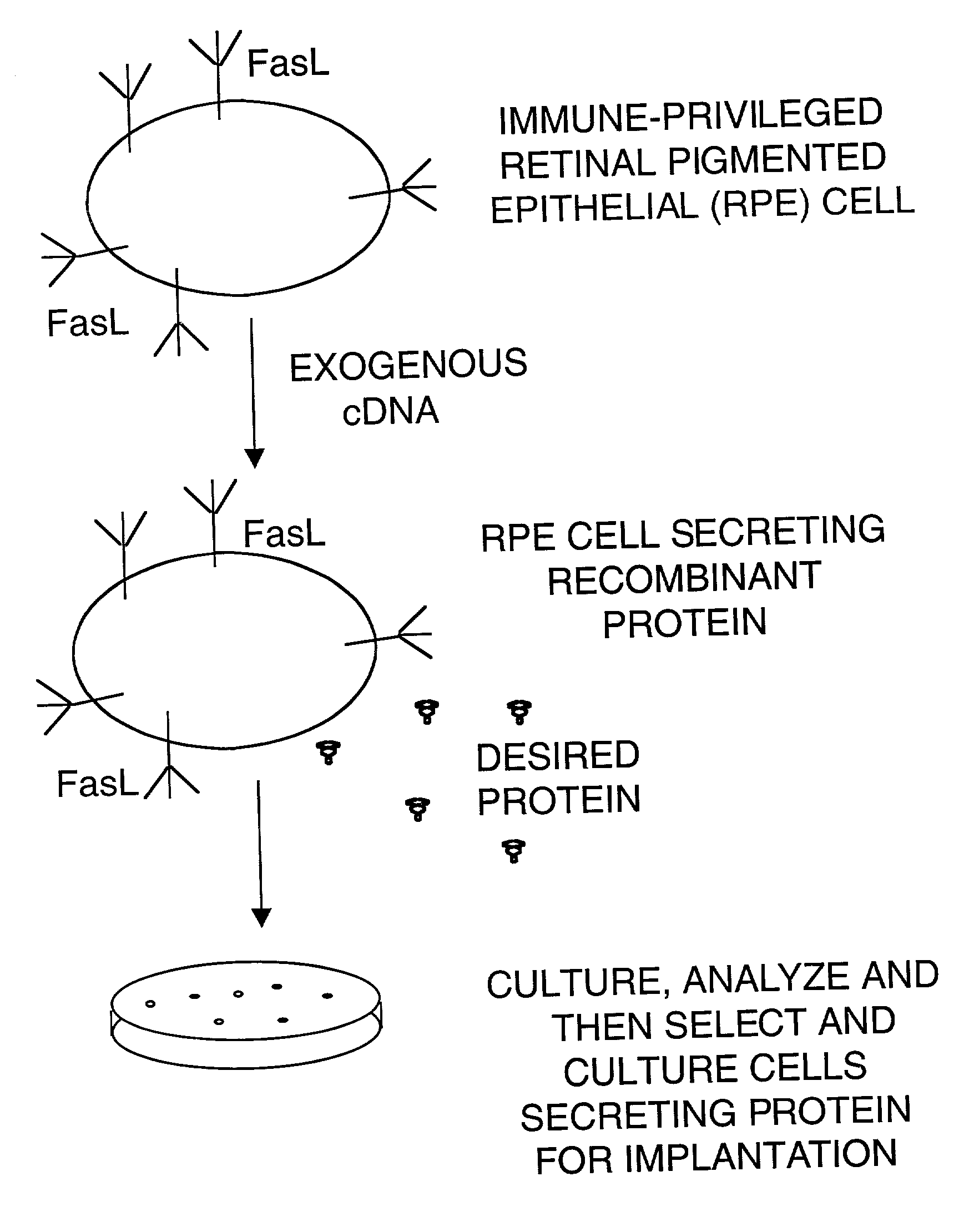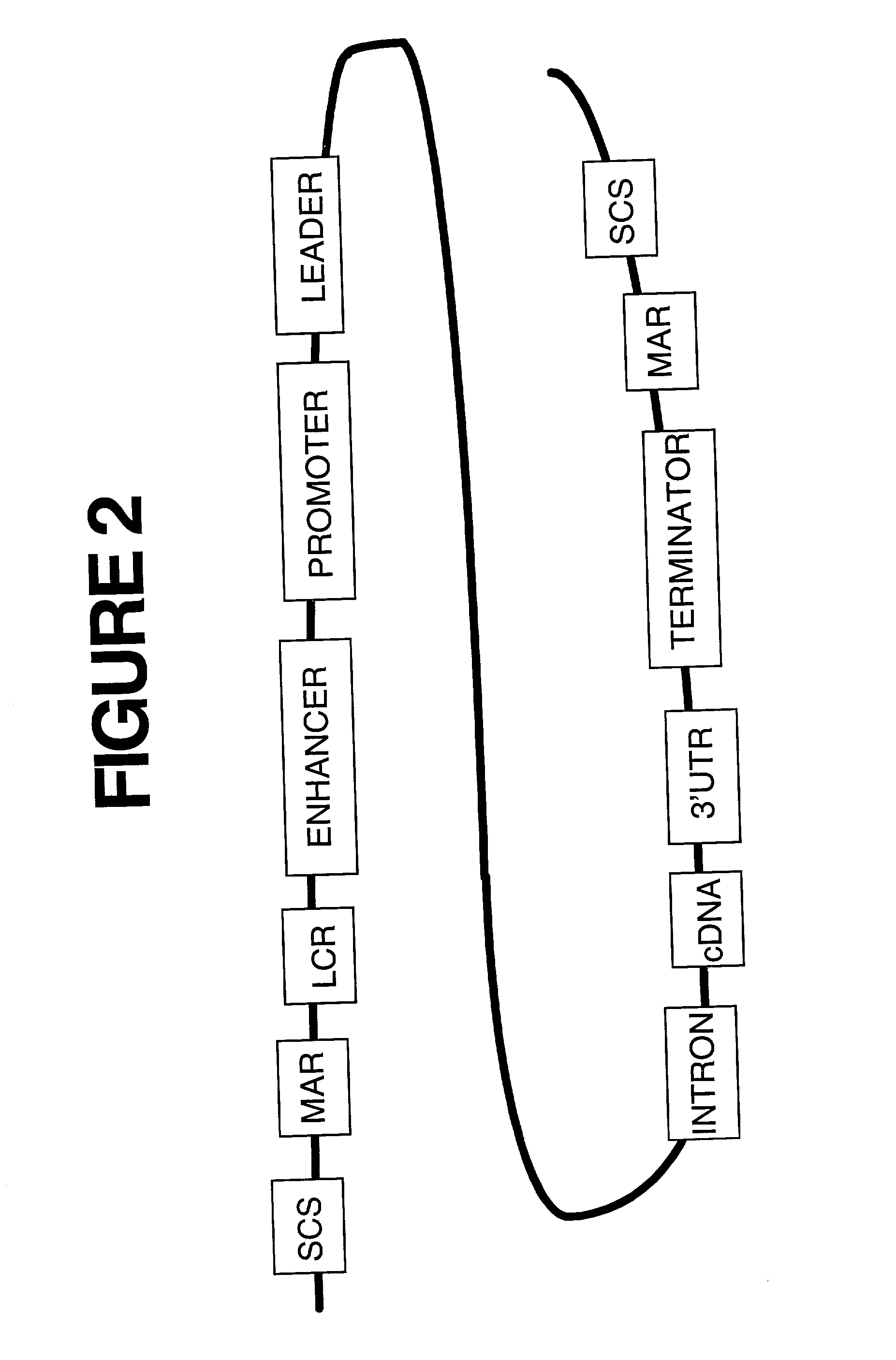Immune privileged cells for delivery of proteins and peptides
- Summary
- Abstract
- Description
- Claims
- Application Information
AI Technical Summary
Benefits of technology
Problems solved by technology
Method used
Image
Examples
exampler 2
[0144] Creation of genetically modified immune-privileged cells from porcine retinal pigment epithelium (RPE) producing human neurotrophin 3 (hNT3). Isolation, purification, tissue culture expansion and cryopreservation of porcine RPE cells. Porcine retinal pigment epithelial (PRPE) cells are isolated from porcine eyes obtained from a local abattoir. Eyes are rinsed in phosphate buffered saline (PBS) containing antibiotics (100U / ml penicillan and streptomycin). The anterior segment, retina and vitreous humor are removed. Eye cups are incubated at 37.degree. C. in 5% CO.sub.2 with 0.3% trypsin in Ca.sup.++ / Mg.sup.++ free PBS, containing 0.5 mM ethylene diamine tetraacetic acid (EDTA) for 45 minutes (Esser et al., 1997; Jaffe et al., 1990). The retinal pigment epithelium is dislodged from Bruch's membrane and cells are gently triturated to achieve a single cell suspension which is plated in Dulbecco's modified Eagle's medium, supplemented with 15% fetal calf serum, 50 .mu.g / ml gentami...
example 3
[0150] Creation of genetically modified rat Sertoli cells producing human NT3 (hNT3). Cell isolation, purification, tissue culture expansion and cryopreservation of rat Sertoli cells. Sertoli cells are isolated from euthanized Sprague-Dawley rats as previously described (Cameron et al., 1987; Korbutt et al., 1997). Testes are removed from the animal, skinned and collected in cold PBS, minced into 1 mm pieces and then subjected to sequential enzymatic treatment at 37.degree. C. using first 0.1% collagenase for 10 minutes (Sigma, St Louis, Mo., type V). This digest is washed 3 times in Ca.sup.++ / Mg.sup.++ free PBS (CMF-PBS) containing 1 mM EDTA and 0.5% bovine serum albumin (Sigma), then digested for 10 minutes at 37.degree. C. with trypsin (0.25 .mu.g / ml) and DNAse (4 .mu.g / ml, Boehringer Mannheim, Indianapolis, Ind.) in CMF-PBS. The resultant cell suspension is suspended in Ham's F10 medium containing 10 mM glucose, 2 mM 1-glutamine, 50 .mu.M isobutylmethylxanthine, 100 U / ml penicil...
example 4
[0156] Transplantation of genetically modified (rat hNT3-producing Sertoli cells and porcine hNT3-producing RPE cells) into a rat model of spinal cord injury. Description and generation of rat model of spinal cord injury. Multiple spinal and supraspinal pathways influence spinal motor and premotor neurons and local pattern generators to produce locomotion (Grill et al., 1997). Incomplete understanding of the contributions of these elements has complicated the use of animal models for spinal cord injury. However, it is clear that rats with a lesion of the dorsal corticospinal tract (CST) did not sustain long-lasting functional deficits, while those with a more extensive dorsal hemisection did (Grill et al., 1997). For this reason, the present experiment uses an extensive dorsal cord lesion to assess the efficacy of neurotrophin delivery. Dorsal hemisection lesions that interrupted multiple motor projections, including the corticospinal, rubrospinal, cerulospinal, and some raphaespina...
PUM
| Property | Measurement | Unit |
|---|---|---|
| Chemically inert | aaaaa | aaaaa |
Abstract
Description
Claims
Application Information
 Login to View More
Login to View More - R&D
- Intellectual Property
- Life Sciences
- Materials
- Tech Scout
- Unparalleled Data Quality
- Higher Quality Content
- 60% Fewer Hallucinations
Browse by: Latest US Patents, China's latest patents, Technical Efficacy Thesaurus, Application Domain, Technology Topic, Popular Technical Reports.
© 2025 PatSnap. All rights reserved.Legal|Privacy policy|Modern Slavery Act Transparency Statement|Sitemap|About US| Contact US: help@patsnap.com



